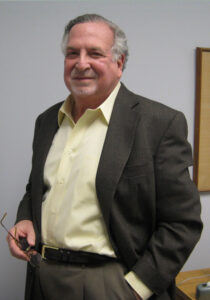Dr. Loewy worked over his decades-long career at Washington University to uncover connections between the peripheral and central nervous systems.

Arthur Loewy’s career started with a PhD in Anatomy from the University of Wisconsin-Madison and culminated in 42 years as a faculty member in the Department of Neuroscience at Washington University. He began as a neuroanatomist, mapping connections between the hypothalamus and autonomic nervous system, which regulates involuntary processes such as breathing and heartrate. Later, he developed tools to trace those same connections with greater precision, paving the way to the widespread use of viruses in neuroscience. All of his work contributed to a greater understanding of how the brain speaks to and regulates diverse functions of the peripheral nervous system, from the fight-or-flight response to salt tasting.
In 1976, Loewy and colleagues showed for the first time that some of the descending hypothalamic pathways connect directly to the preganglionic nuclei of the peripheral nervous system. Before this study, researchers had speculated that the autonomic nervous system was under control of the central nervous system. But the 1976 paper was one of the first to confirm this by identifying a neuronal network in the brain controlling neurons in the autonomic nervous system. In a commentary about the study published in 2016, Loewy and two of his coauthors on the 1976 paper wrote, “The findings in the 1976 paper focused Arthur Loewy on studying central autonomic control pathways, a direction that he and his collaborators have pursued for almost 40 years.”
This technique was monumentally important in figuring out the connections of the brain to the sympathetic nervous system.
Joel Geerling, MD, PhD
During that time, he continued to make profound contributions to the field, including technique innovations. In 1990, Loewy and then-graduate student Alison Strack developed a tool that allowed them to trace these central and peripheral nervous system connections with greater precision than the horseradish peroxidase they injected the neurons with in 1976. Horseradish peroxidase was a commonly used retrograde tracer but is limited in sensitivity due to its inefficient uptake by neurons. In the preceding decade, others in the field had pioneered the use of viruses as retrograde tracer. In search of an even better tracer, Loewy and Strack demonstrated that the Bartha strain of pseudorabies virus, a version of herpesvirus that is used to vaccinate pigs, travels backwards from postsynaptic to presynaptic neurons. Loewy and Strack deployed the virus to trace connections in the sympathetic nervous system of rats. Not only was this technique “monumentally important in figuring out the connections of the brain to the sympathetic nervous system,” said Joel Geerling, MD, PhD, a former Loewy Lab MD/PhD student who is now a clinician scientist at the University of Iowa, it also paved the way for the widespread usage of viruses as tools to manipulate and assess neuronal networks.
Loewy and his team leveraged this technique in 1995 to find the neurons that are responsible for the fight-or-flight response. While researchers had predicted since the 1920s that so-called “command neurons” existed in the central nervous system to regulate sympathetic responses, finding those neurons proved tricky. In work published in Science, Loewy and his coauthors described the use of two engineered strains of pseudorabies virus to locate those command neurons in several regions of both the brain and spinal cord of rats.
Several years after this discovery, Geerling started at WashU as a medical student and after spending time in Loewy’s lab following his first year of medical school he switched gears to the Medical Scientist Training Program to incorporate a PhD. And while the research was fascinating, it was also Loewy’s support and mentorship that drew Geerling to work with him. “He talked to me like an adult, like an equal,” Geerling explained.
They embarked together on a project to better understand a subset of neurons located in the lower brainstem that are particularly sensitive to the hormone aldosterone, known as HSD2 neurons. The original idea, Geerling said, was that—because aldosterone is important for regulating blood volume, blood pressure, and renal sodium excretion—these neurons would be another link between the central and the sympathetic nervous systems. Instead, as they mapped out the HSD2 neuronal connections, they found that these neurons are active when sodium appetite is high, and then they get shut off when rats eat salt or drink saline.
It wasn’t a traditional story of connection between central and peripheral, but Loewy embraced their exploration of neuronal and hormonal control of sodium appetite, working with Geerling and others for years on this new direction, publishing multiple papers and reviews along the way. “Anybody who knows Arthur will always tell you that he was most proud of the project he was currently working on,” said Paul Shaw, a Professor of Neuroscience at WashU whose lab neighbored Loewy’s for more than a decade.
“He was a forward-looking scientist, and he had great questions,” Shaw continued. Loewy made contributions—both scientifically and as a colleague and friend. “Even at the end, he was at the bench doing science, but he still would check in on everybody to make sure they were doing okay,” Shaw added. Before Loewy passed away in 2017, Geerling would visit him in hospice care and their conversations were just as intense as when they were in the lab. “When we talked about science, he would just come alive.”